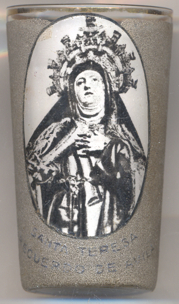

|
| ESPAÑA | Spain |
| Castilla y León | Castile and León |
| Provincia: Ávila | Ávila |
Ávila is the capital of the province of Ávila in the autonommous community of Castile and León of western Spain. Situated at an elevation of 1,132 metres on a rocky outcrop on the right bank of the Adaja river, a tributary of the Duero, Ávila is the highest provincial capital in Spain. The municipality has a population of about 58,100 (2017).
 In pre-Roman times (5th century BC), Ávila was inhabited by the Vettones, who called it Obila ("High Mountain")
and built one of their strongest fortresses here. Ávila may have been the ancient town known as Abula,
mentioned by Ptolemy in his Geographia (II 6, 60) as being located in the Iberian region of Bastetania. Abula
is mentioned as one of the first towns in Hispania that was converted to Christianity by Secundus of Abula (San Segundo);
however, Abula may alternatively have been the town of Abla. After the conquest by ancient Rome, the town was called
Abila or Abela. The plan of the town remains typically Roman; rectangular in shape, with its two main streets
intersecting at a forum in the centre. By tradition, in the 1st century, Secundus, having travelled via the Roman province
of Hispania Baetica, brought the Gospel to Ávila, and was created its first bishop. After the fall of the Western Roman
Empire, Ávila became a stronghold of the Visigoths. Conquered by the Moors (Berbers/Arabs) (who called it Ābila,
آبلة), it was repeatedly attacked by the northern Iberian Christian kingdoms, becoming a virtually
uninhabited no man's land. It was repopulated about 1088 following the definitive reconquest of the area by Raimundo de
Borgoña (Raymond of Burgundy), son in law of Alfonso VI of León and Castile. The city achieved a period
of prosperity under the Catholic Monarchs in the early 16th century, and their successors Emperor Charles V (Carlos I of
Spain) and Philip II of Spain, but began a
long decline during the 17th century. In the 19th century, there was some population growth with the construction of the
railway line from Madrid to the French border at Irun and an important junction near the town. Growth continued slowly again
in the early and mid-20th century.
In pre-Roman times (5th century BC), Ávila was inhabited by the Vettones, who called it Obila ("High Mountain")
and built one of their strongest fortresses here. Ávila may have been the ancient town known as Abula,
mentioned by Ptolemy in his Geographia (II 6, 60) as being located in the Iberian region of Bastetania. Abula
is mentioned as one of the first towns in Hispania that was converted to Christianity by Secundus of Abula (San Segundo);
however, Abula may alternatively have been the town of Abla. After the conquest by ancient Rome, the town was called
Abila or Abela. The plan of the town remains typically Roman; rectangular in shape, with its two main streets
intersecting at a forum in the centre. By tradition, in the 1st century, Secundus, having travelled via the Roman province
of Hispania Baetica, brought the Gospel to Ávila, and was created its first bishop. After the fall of the Western Roman
Empire, Ávila became a stronghold of the Visigoths. Conquered by the Moors (Berbers/Arabs) (who called it Ābila,
آبلة), it was repeatedly attacked by the northern Iberian Christian kingdoms, becoming a virtually
uninhabited no man's land. It was repopulated about 1088 following the definitive reconquest of the area by Raimundo de
Borgoña (Raymond of Burgundy), son in law of Alfonso VI of León and Castile. The city achieved a period
of prosperity under the Catholic Monarchs in the early 16th century, and their successors Emperor Charles V (Carlos I of
Spain) and Philip II of Spain, but began a
long decline during the 17th century. In the 19th century, there was some population growth with the construction of the
railway line from Madrid to the French border at Irun and an important junction near the town. Growth continued slowly again
in the early and mid-20th century.
 Saint Teresa of Ávila, also called Santa Teresa de Jesús, baptized
as Teresa Sánchez de Cepeda y Ahumada was born in Ávila on 28 March 1515. She was a prominent Spanish
mystic, Roman Catholic saint, Carmelite nun, author, and theologian of contemplative life through mental prayer. Active
during the Counter-Reformation, she was a reformer in the Carmelite Order of her time; the movement she initiated, later
joined by Saint John of the Cross, eventually led to the establishment of the Discalced Carmelites, though neither she nor
John were alive when the two orders separated. She died on 4 October 1582 in Alba de Tormes, Salamanca. In 1622,
forty years after her death, she was canonized by Pope Gregory XV, and, on 27 September 1970, she was named a
Doctor of the Church by Pope Paul VI.
Saint Teresa of Ávila, also called Santa Teresa de Jesús, baptized
as Teresa Sánchez de Cepeda y Ahumada was born in Ávila on 28 March 1515. She was a prominent Spanish
mystic, Roman Catholic saint, Carmelite nun, author, and theologian of contemplative life through mental prayer. Active
during the Counter-Reformation, she was a reformer in the Carmelite Order of her time; the movement she initiated, later
joined by Saint John of the Cross, eventually led to the establishment of the Discalced Carmelites, though neither she nor
John were alive when the two orders separated. She died on 4 October 1582 in Alba de Tormes, Salamanca. In 1622,
forty years after her death, she was canonized by Pope Gregory XV, and, on 27 September 1970, she was named a
Doctor of the Church by Pope Paul VI.
[https://de.wikipedia.org/wiki/Ávila, https://en.wikipedia.org/wiki/Ávila,_Spain;
https://en.wikipedia.org/wiki/Teresa_of_Ávila]
![[scale]](lineal.jpg)